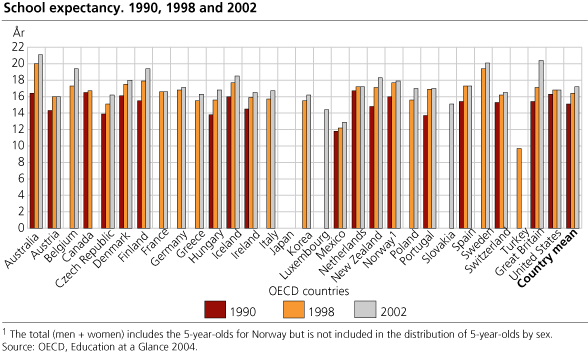Indicators on Education, in the OECD, 2001/02
School expectancy 17.9 years in Norway
Published:
The expected years of schooling for a five year old child were 17.9 in Norway in 2002, while the OECD average was 17.2. Compared with the other Nordic countries, Norway had the lowest school expectancy.
- Series archive
- Indicators on education in the OECD

In 1990, the expected years of schooling in Norway were 16 years. This figure had risen to 17.7 in 1998. One important explanation for the increase between 1990 and 1998 is Reform 97, a reform that lowered the school starting age from seven to six.
Only three countries had higher school expectancy than Norway in 1998. In 2002, however, this number had risen to eight. The other Nordic countries and Australia, Belgium, New Zealand and the UK all had higher school expectancy for five year olds than Norway.
In all OECD countries except Germany, Japan, Korea, the Netherlands and Switzerland girls were likely to spend more time in education than boys.
Majority of late teens in education
85.3 per cent of the Norwegian population aged 15-19 was enrolled in education in 2002, compared with an OECD average of 81.8 per cent. Eleven countries had a higher proportion of 15-19 year olds in education. In this age group more women than men were in education – 88.8 per cent of women and 81.8 of men respectively.
In the age group 25-29, nine countries had a higher proportion of students than Norway. Iceland tops the list with 36.5 per cent, compared with 14.2 per cent in Norway.
Increasing proportions of foreign students
In all OECD countries except Poland, Turkey and the UK the proportion of foreign students was higher in 2002 than in 1998. In Norway, 4.8 per cent of students were of foreign nationalities in 2002, compared with 3.2 per cent in 1998.
In seven countries foreign students make up more than 10 per cent of the student population. New Zealand, the Czech Republic and Iceland have had the steepest increase in the proportion of foreign students from 1998 to 2002. Looking at differences between men and women, we find that in almost half of the OECD countries women make up the majority among foreign students. Iceland has the largest proportion of women among foreign students with 63.6 per cent.
In 2002, 24.4 per cent of Norwegian students abroad were enrolled in tertiary education in Australia, making it the most popular destination for Norwegian students abroad. The USA and the UK are most popular if we look at the Nordic region as a whole. Large numbers of Nordic students also participate in tertiary education in other Nordic countries.
The statistics are part of Education at a Glance 2004, which was published on 14 September. Education at a Glance is published by the OECD ( http://www.oecd.org/ ).
Tables
Table 2 Percentage of the youth population in education, by age group and gender. 2002
Table 4 Percentage of citizens studying abroad in tertiary education, by country of study. 2002
Table 5 Percentage of advanced research degrees awarded to women.
Contact
-
Geir Nygård
-
Statistics Norway's Information Centre
